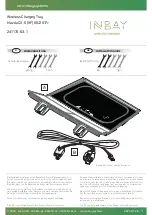and the charge process will restart. This occurs only with
batteries that are already fully charged, and consequently
should not be recharged. If the battery voltage has not
reached the Li-Ion battery qualification voltage (CEL-pin
>
1.2V) within 1 minute of the Qualification Phase, the battery
is considered to be defective, and the charger goes into error
mode. It stays there until the battery is removed (CEL-pin
<
1.0V).
The next phase is Fast Charge Constant Current. During this
phase the current is constant, and the battery voltage will
slowly rise (due to the charging). When the battery has
reached its maximum battery voltage (CEL at 2.675V or
2.74V, depending on SEL3, it will go to the next phase which
is Fast Charge Constant Voltage.
During this phase, the charger will keep the voltage constant
and stay in this phase until the current has decreased to a
threshold value (CS at 2.3V).
The battery is now fully charged, and the charger can
behave in different modes, depending on SEL1. It can either
maintenance charge the battery and restart the charge
process if the battery voltage drops below the maintenance
restart threshold value (CEL
<
2.153V), or just maintenance
charge the battery and don’t restart the charge process if the
battery
becomes
discharged.
The
last
mode
is
no
maintenance charge, and restarts the charge process if the
battery voltage drops below the maintenance restart
threshold value (CEL
<
2.153V).
1.2.2.1
Components Critical to Total Charger
Performance
•
The capacitance C2 connected to CEXT must be of a
type that has low internal resistance, low loss, high
stability and low dielectric absorption. The capacitance
mounted on the Demo Board is a metallized polyester
type from WIMA, 2220 series.
•
The operational amplifiers U1 and U2 must be capable of
rail-to-rail output, and have a high PSRR (PowerSup-
plyRejectionRatio), because they are both powered
directly from the unregulated DC-input. U1 must also
have enough current drive to control the transistor Q3. U2
should preferably have a low input offset, since this error
will be amplified.
•
The regulator IC2 criteria is that it has to be able to
handle the input DC-voltage, and deliver enough current
to drive the circuitry (all LED’s, buzzer, LM3647).
•
The transistor Q3 must be able to handle the charge
current and (depending on charge current) must be
provided with an adequate heatsink.
•
The transistor Q2 must be able to handle the maximum
discharge current.
•
The Diode D1 must be able to handle the maximum
charge current.
1.2.2.2
Clarifications Regarding Circuit Schematics
The circuitry with Q4, R26 and R27 (see section below) is
used to protect the battery from excessive charge current.
When the current flows through the current sense resistor
R9, and is amplified by U2, the voltage at U2’s output drops
from 2.5V until Q4 starts conducting. It discharges the
RC-network that generates the DC-voltage from the
PWM-output of the LM3647.
1.2.2.3
Setting The Charge Timeout
The LM3647 uses the charge timeout value as a backup
termination method if the normal termination methods fail.
The charge timeout also controls the length of some of the
phases like the Topping Charge phase (Ni-Cd/Ni-MH). The
timeout is selectable from a charge rate of 3.2C to 0.4C. The
table below shows which values will result in a certain
timeout.
TABLE 1. Charge Timeouts
R Value
C Value
Ni-Cd/Ni-MH
Fast Charge
(minutes)
Ni-Cd/Ni-MH
Topping (minutes)
Li-lon CC
(minutes)
Li-lon CV
(minutes)
Appropriate
Charge Rates
100 k
Ω
0 nF
75
20
50
75
3.2C
100 k
Ω
10 nF
100
25
70
100
2.4C
100 k
Ω
15 nF
160
40
110
160
1.4C
100 k
Ω
22 nF
190
50
130
190
1.2C
100 k
Ω
33 nF
260
65
170
260
0.9C
100 k
Ω
47 nF
330
80
220
330
0.7C
100 k
Ω
68 nF
450
115
300
450
0.5C
100 k
Ω
100 nF
540
135
360
540
0.4C
EXAMPLE 1:
AN101315-18
AN-1
164
www.national.com
3


















